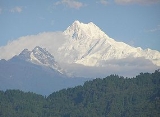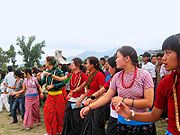
Pathibhara
Encyclopedia
Pathibhara is a village development committee in Sankhuwasabha District
in the Kosi Zone
of north-eastern Nepal
. At the time of the 1991 Nepal census
it had a population of 2905 people living in 607 individual households. The population are predominantly of Limbu
descent.
in the northeast of the country. Pathibhara borders Pawakhola
to the east, Num
to the south, Makalu
to the west and Hatiya
to the north. It lies in proximity to Kangchenjunga
(8586 m), the world's third highest peak. The area has an abundance of flora and fauna, with the landscape ranging from Alpine grassland, to subtropical forests.
The temple, according to local legend which has passed down from one generation to the next, was founded by shepherds who had led their flock to where the temple lies today. Hundreds of sheep disappeared as they were grazing, and later the shepherds had a prominent dream in which they were instructed by the Goddess of Trust and Faith, Devi
, to make a ritualistic sacrifice. When the sacrifice was offered and the temple and the statue of Devi were constructed, the lost sheep were said to have returned.
 According to the 2001 census in Nepal, accounting for the permanent population in Pathibhara, 660 people were Hindu, 664 Buddhist and 1824 people were of the Kirant Mundhum faith.
According to the 2001 census in Nepal, accounting for the permanent population in Pathibhara, 660 people were Hindu, 664 Buddhist and 1824 people were of the Kirant Mundhum faith.
Sankhuwasabha District
Sankhuwasabha District of 159,203.Indigenous ethnics Yakkhas, Rais, Limbus, and other hill castes and ethnic groups Sankhuwasabha District of 159,203.Indigenous ethnics Yakkhas, Rais, Limbus, and other hill castes (e.g. Chhetri, Bahuns) and ethnic groups Sankhuwasabha District of...
in the Kosi Zone
Kosi Zone
Koshi Zone Koshi Zone is divided into six districts:*Bhojpur District*Dhankuta District*Morang District*Sankhuwasabha District*Sunsari District*Terhathum District-See also:*Zones of Nepal*Regions of Nepal*Districts of Nepal...
of north-eastern Nepal
Nepal
Nepal , officially the Federal Democratic Republic of Nepal, is a landlocked sovereign state located in South Asia. It is located in the Himalayas and bordered to the north by the People's Republic of China, and to the south, east, and west by the Republic of India...
. At the time of the 1991 Nepal census
1991 Nepal census
The 1991 Nepal census was a widespread national census conducted by the Nepal Central Bureau of Statistics.Working with Nepal's Village Development Committees at a district level,...
it had a population of 2905 people living in 607 individual households. The population are predominantly of Limbu
Limbu people
The Yakthung or Limbu tribes and clans belong to the Kirati nation or to the Kirat confederation.They are indigenous to the hill and mountainous regions of east Nepal between the Arun and Mechi rivers to as far as Southern Tibet, Bhutan and Sikkim....
descent.
Geography
Pathibhara is located in the HimalayasHimalayas
The Himalaya Range or Himalaya Mountains Sanskrit: Devanagari: हिमालय, literally "abode of snow"), usually called the Himalayas or Himalaya for short, is a mountain range in Asia, separating the Indian subcontinent from the Tibetan Plateau...
in the northeast of the country. Pathibhara borders Pawakhola
Pawakhola
Pawakhola is a village development committee in Sankhuwasabha District in the Kosi Zone of north-eastern Nepal. At the time of the 1991 Nepal census it had a population of 2602 people living in 472 individual households.-External links:*...
to the east, Num
Num, Nepal
Num is a village development committee in Sankhuwasabha District in the Kosi Zone of north-eastern Nepal. At the time of the 1991 Nepal census it had a population of 2526 people living in 468 individual households.-External links:*...
to the south, Makalu
Makalu, Nepal
Makalu is a village development committee in Sankhuwasabha District in the Kosi Zone of north-eastern Nepal. At the time of the 1991 Nepal census it had a population of 3560 people living in 694 individual households.-External links:*...
to the west and Hatiya
Hatiya, Kosi
Hatiya is a village development committee in Sankhuwasabha District in the Kosi Zone of north-eastern Nepal. At the time of the 1991 Nepal census it had a population of 2824 people living in 585 individual households.-External links:*...
to the north. It lies in proximity to Kangchenjunga
Kangchenjunga
Kangchenjunga is the third highest mountain of the world with an elevation of and located along the India-Nepal border in the Himalayas.Kangchenjunga is also the name of the section of the Himalayas and means "The Five Treasures of Snows", as it contains five peaks, four of them over...
(8586 m), the world's third highest peak. The area has an abundance of flora and fauna, with the landscape ranging from Alpine grassland, to subtropical forests.
Religion
The major attraction of note is the Pathibhara Devi temple, commonly a site attended by Hindu and Buddhist pilgrims seeking spiritual fulfilment and to celebrate special occasions. The Pathibhara Festival is held in this respect annually at the end of March and generally lasts a week. Pilgrims flock from all over Nepal and India], often sacrificing animals and bringing gold and silver as offerings. The mountain Pathibhara Devi (3794 m), also takes the name of the temple.The temple, according to local legend which has passed down from one generation to the next, was founded by shepherds who had led their flock to where the temple lies today. Hundreds of sheep disappeared as they were grazing, and later the shepherds had a prominent dream in which they were instructed by the Goddess of Trust and Faith, Devi
Devi
Devī is the Sanskrit word for Goddess, used mostly in Hinduism, its related masculine term is deva. Devi is synonymous with Shakti, the female aspect of the divine, as conceptualized by the Shakta tradition of Hinduism. She is the female counterpart without whom the male aspect, which represents...
, to make a ritualistic sacrifice. When the sacrifice was offered and the temple and the statue of Devi were constructed, the lost sheep were said to have returned.


